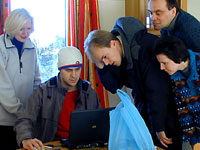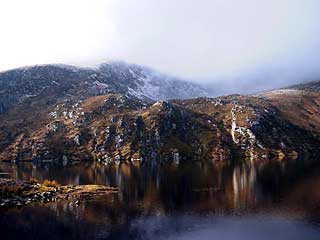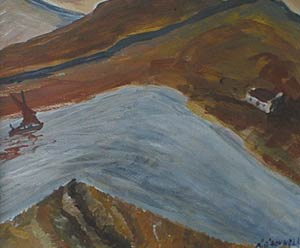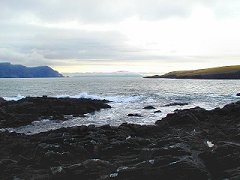

We once had a technical team
Whose job was really a dream
They had nothing to do
But sit in Cottage 2
And occasionally look at a screen!
- A tribute to the technical guys!

Photo workshop
First we worked together with Sean on our reports and poems. After
this we looked at our photos on the computer and chose the photos
that we wanted to combine with our words. Then we prepared our Power-point
Presentation for Friday evening.
In the afternoon we had a wonderful trip with Tim round Achill and
later some of us again worked on our photo collection.
 "Relax,
free your mind, just let it happen !" With these words Joseph invited
his painting novices into his studio. Experimental brush strokes with water
colour were made in preparation for the so-called happy accident, the mix
of knowing what to draw and letting the dynamic movement of colours work
for you.
"Relax,
free your mind, just let it happen !" With these words Joseph invited
his painting novices into his studio. Experimental brush strokes with water
colour were made in preparation for the so-called happy accident, the mix
of knowing what to draw and letting the dynamic movement of colours work
for you. After completing individual paintings produced with watercolour and pastels the "happy man" led us to his coffee shop so we could have a rest. His traditional food, scones and tea, tasted even better than on Monday.
"Everyone´s happy ?" Joseph´s words gave the rest the right mood and motivation to start to work on our final group painting although the heaters quit working several times. He put his "Laissez faire" plan of work into action and left the studio.
After several discussions about how to start on this masterpiece six people were fully occupied, and lost all sense of time and place. We simply let it happen.
Satisfied with their products the O´Donnells left the art metropolis on Achill, some will come back…happy.
Bus Excursion
Tim Daly took us for a ride on his minibus, telling us lots of things
about the island as we went along. The weather was really fine today,
with sunshine and bright colours everywhere. Our first stop was at one
of the two Protestant churches on Achill Island. In the 19th century,
Edward Nangle had founded a Protestant mission on the island, providing
people with free soup and supporting their education. However, the people
who became Protestants in order to secure this support for themselves
were called "soupers", and this word is still considered a bad insult.
There are seventeen villages on Achill Island; for them, there are six
Roman Catholic churches and two Church of Ireland churches. Apart from
the religious divisions, the island is divided into a Gaelic-speaking
part and an English-speaking part. However, in the English-speaking part,
the language survives through music and songs. In the distance, we could
see a National Park consisting of 400 square miles of wilderness, featuring
some of the oldest recorded rocks in the world. Lots of minerals are concentrated
in a small area and have a distinct influence on the fauna and flora of
the area. Achill Island has its own Loch Ness monster, too. In a very
deep glacial sea, someone saw a beast swimming deep underneath the surface.
Teams of biologists with underwater cameras, sonar systems, and other
technical equipment turned up and spent quite a time looking for the strange
animal; however, nothing was found. Years later, someone else claimed
to have seen the monster; but some pints of Guiness are more likely to
be involved in this apparition than a real animal. Cutting turf was one
central aspect of the Achill culture. In the boglands, 5000 years of farming
on the acidic ground developed a great spirit of co-operation. People
would do the digging together, cut the turf together, and have their breakfast
together. The large pot of tea would always be filled up by adding water
and more tea - so that the last bit of tea in the pot must have been thicker
than Guiness. Now that the habits of life are changing and co-operation
is no longer required, it is very difficult to preserve this old culture
of community. Within the context of our project, we also stopped at the
former train station just behind the turning bridge leading to the island.
The train service has stopped many years ago, and the former track is
starting to disappear.  The
old station buildings are now used for private purposes (storage, ...).
The station is very unlikely to be brought back into service. We passed
a number of derelict houses, as emigration went on until the 1980s, when
the tides turned and people started coming back. Many of the emigrants
who are still in Scotland, England, the United States etc. emigrated more
than a hundred years ago, e.g. in the years of the Great Famine. In the
Kildownet Cemetery, we found the graves of some victims of this famine,
and we were told that the potato blight brought great difficulties for
all the families who had relied on potato farming for their living. Many
of them suffered from malnutrition or even died. Though many people tend
to blame the English for not recognising the plight of the Irish, much
of the help in those days came from England, too. We also passed one of
Grace O'Malley's watch towers on the Atlantic Drive. This Pirate Queen
used to be quite powerful - and one of the reasons for that was the fact
that her small boats were able to pass the shallow waters around the island,
whereas the bigger vessels of their victims couldn't really follow them.
Perhaps the most spectacular part of our trip was the ride along the Atlantic
Drive and up to Keem Bay, where we could see the cliffs, walk on the beaches
and experience the absolutely impressing atmosphere of the place.
The
old station buildings are now used for private purposes (storage, ...).
The station is very unlikely to be brought back into service. We passed
a number of derelict houses, as emigration went on until the 1980s, when
the tides turned and people started coming back. Many of the emigrants
who are still in Scotland, England, the United States etc. emigrated more
than a hundred years ago, e.g. in the years of the Great Famine. In the
Kildownet Cemetery, we found the graves of some victims of this famine,
and we were told that the potato blight brought great difficulties for
all the families who had relied on potato farming for their living. Many
of them suffered from malnutrition or even died. Though many people tend
to blame the English for not recognising the plight of the Irish, much
of the help in those days came from England, too. We also passed one of
Grace O'Malley's watch towers on the Atlantic Drive. This Pirate Queen
used to be quite powerful - and one of the reasons for that was the fact
that her small boats were able to pass the shallow waters around the island,
whereas the bigger vessels of their victims couldn't really follow them.
Perhaps the most spectacular part of our trip was the ride along the Atlantic
Drive and up to Keem Bay, where we could see the cliffs, walk on the beaches
and experience the absolutely impressing atmosphere of the place.
Contact the team! | Meet us @ events! | Achill finale
